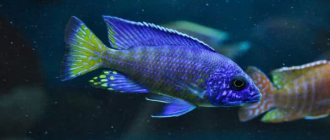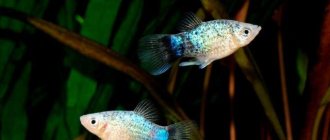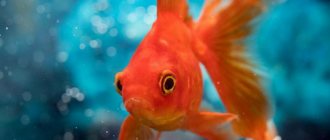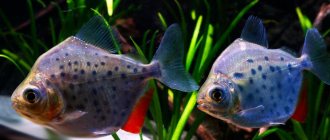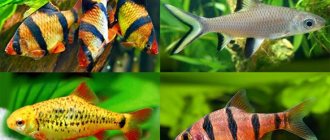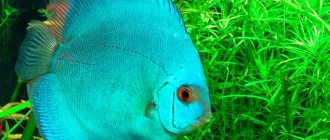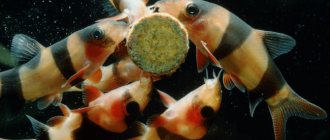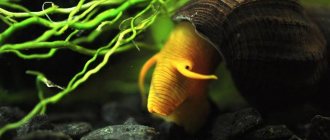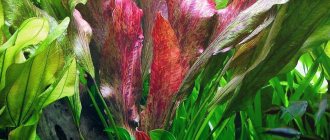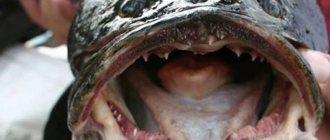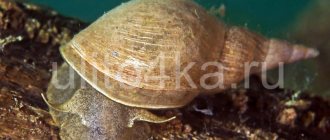5
(3)
Lake Malawi cichlids have always been particularly popular among aquarists. Not surprising, because these are special fish. They are very interesting to watch. They received a bright, unusual color from nature and therefore do not need selection or artificial “decoration”. It is difficult to identify any specific species from these animals. However, aulonocara occupies a special place among them.
Aulonocara species
Malawian cichlids are distinguished by pronounced sexual differences: only males are bright and beautiful. The female is always faded, and by the color of the male you can understand what species the representative belongs to. Describing the colors of each species is not an easy task. What all species have in common is the presence of many sparkling scales that glisten even in poor lighting.
- Aulonocara orchid, strawberry - a captive-bred variety, has a bright color with a predominance of rich red. The head up to the gill covers is bluish-pearl with red inclusions. Blue is found on the dorsal fin in the form of thin stripes and on the caudal fin in the form of round spots;
- Aulonocara multicolor is one of the popular breeding species. The main body color is orange from yellow to red. Closer to the tail, the scales are colored blue in places, making the color transition clearly visible. At a certain lighting angle, slightly darker transverse stripes appear. There are black spots of irregular shape throughout the body, including the fins. The fins themselves can be colored to match the body color or a contrasting blue shade;
- aulonocara nyasa, aulonokara queen nyasa - fish of a rich blue-violet color. Males have color transitions into red-blue and yellowish, closer to the anal fin they can turn almost black, females are uniformly blue with dark transverse stripes and lighter spots of irregular shape. The characteristic transverse stripes range in color from dark blue to black and may fade if the fish is frightened. The anal fin may have an orange-red border; the spinal fin most often has a light, almost white border;
- aulonocara bensha, golden queen - lemon yellow color predominates. There may be small blue spots throughout the body. The lower part of the head is bluish-pearl. The transverse stripes have a lighter shade compared to the entire body;
- Aulonocara red flash is a selection variety, similar to Nyasa, but the color does not turn black, and behind the gills the transition to red is clearly visible. The pectoral fins are also bluish-red, with a blue ray in front. The vertical stripes are dark, with a purple tint. The border on the dorsal fin is bluish-white;
- Aulonocara red ruby is a breeding form. There are two main body colors - red and blue. The body of the fish is red with purple transitions and transverse dark stripes. The head is blue, and the fins combine these two shades equally;
- Aulonocara mailanda is a blue fish with dark transverse stripes and a bright yellow stripe from the upper lip to the dorsal fin. In some, the yellow extends to the fin, forming an edge. Females are also blue, slightly paler and smaller;
- Aulonocara freiberga, the Malawian butterfly, is the largest representative of the species (can grow up to 17 cm). The color is similar to red ruby. The difference is in the luxurious fins. The dorsal is higher than that of other fish, with a clear figured edge, colored almost white. The caudal blade is forked: the rays are longer at the edges, gradually shortening towards the middle;
- aulonocara red dragon is a hybrid form, on a red background there is a small number of bluish streaks that sparkle in good lighting. The eyes are yellow;
- aulonocara stewart grant, stewartgranti - has several color variations: blue, yellow-greenish or with two shades - blue and orange. Blue fish have transverse dark stripes, a white edging on the dorsal fin and a reddish-yellow edging on the anal fin. The orange ones are noticeable by the dark blue head and the same fins, with a light blue edging on the dorsal fin. Mixed color: the lower part of the head is blue, the upper part is blue, this color extends to the tail along the back. The belly, lower half of the body and tail are orange, all fins are blue-blue;
- aulonocara rosea, aulonocara rose - a breeding form, painted in shades of pink with transitions from pale to rich colors and round spots on the fins.
Description
The fish have the same morphological features as other representatives of the genus: a tall body with a large head, a dorsal fin stretching along the entire back, and pointed ventral fins. Adults reach a length of up to 12–13 cm.
The key feature of this hybrid is the bright body coloration with predominant pink, red or orange colors and bluish speckled fins. This coloring is characteristic exclusively of sexually mature males. Adult females are somewhat smaller in size and have a nondescript gray color.
In the first 10–13 months of life, sexual dimorphism is weakly expressed, both sexes look the same with a predominance of silvery shades.
How to keep aulonocara
The appearance of the fish is influenced by the conditions of detention, primarily the size of the aquarium. If the fish is placed in a small volume, it will not reach the peak of beauty and will not gain full color. How long do aulonocaras live in a home aquarium - up to 10 years with excellent maintenance and much less if care is insufficient.
Arrangement of the aquarium
- aquarium volume – for a school of fish 3-4 pieces – from 150 liters. The larger the volume, the more fish you can stock. An aquarium with cichlids is always alive, filled with movement, so a small volume is not suitable;
- a good solution would be fine sand or river soil 3-5 mm, the color does not matter, you can focus on the design features;
- The filter must be external, since the volume is large. The external filter copes well with contaminants, maintains water parameters and enriches it with useful elements;
- aeration – round the clock, quite active;
- It depends on the lighting whether the aulonokara will look advantageous. The beauty of the color is especially noticeable in diffused light, as well as in the rays of special lamps with shades;
- Artificial plants need to be firmly dug into the ground, as designer cichlids like to rearrange everything. Living plants are practically unsuitable for cichlids (with the exception of Vallisneria and Echinodorus), since most do not withstand constant excavations, grow poorly and die. Plants floating on the surface can be an excellent vitamin supplement to the fish’s diet;
- the decor necessarily includes stones, driftwood, caves.
Water parameters
- temperature 24-29°C;
- hardness 12-25°;
- acidity 7.6-8.6 pH;
Maintenance and care
- weekly change of a fifth of the water;
- cleaning the soil with a siphon 1-2 times a month.
Conditions of detention
In order for the fish to maintain its bright color, live long and be healthy, it is important to create comfortable living conditions for it:
- Choosing an aquarium . Large and active fish require a fairly large amount of free space. Therefore, the minimum volume of the tank, designed to contain 4-6 individuals, must be at least 200 liters. If there are a larger number of fish or proximity to other aquarium inhabitants, the volume of the artificial reservoir should be 400 liters or more.
- Water parameters : temperature - from +22 to +26°C; hardness - from 10 to 77 dGh; acidity - from 15 to 25 units.
- Filtration must be powerful and constant. Aulonocara is sensitive to indicators of the chemical qualities of the aquatic environment, so it is important to avoid increasing ammonia levels and silting of the soil.
- Aeration is necessary for these fish, which require increased amounts of oxygen.
- Vegetation . In the natural environment, aulonocara lives in reservoirs where there are no green spaces. Therefore, the presence of vegetation in an artificial reservoir is also not necessary. If you want to use aquatic and surface crops to decorate your aquarium, it is important to choose plants with a strong root system that fish cannot damage.
- Lighting . The best option would be moderate and diffuse lighting, which will also highlight the natural beauty of these fish.
- Decorating an aquarium . When creating an aquarium design, you need to take care of the presence of secluded corners in it, which can be decorative castles, caves and grottoes, and various driftwood. However, experts do not advise overusing decorative elements, since aulonocaras require a lot of space to move freely in the aquatic environment.
- The soil . It is recommended to give preference to sandy soil.
- Replacing water . Aulonocaras need clean water. Therefore, the fluid in the aquarium must be replaced at least once a week by 25% of the total volume of water in the tank.
Caring for aulonocara is simple. The main thing is to take care of a spacious aquarium and keep it clean.
What to feed
For predators, the basis of the diet is live food: bloodworms, pollock fillets, and shrimp. You can feed both fresh and frozen food.
In addition to protein foods, plant supplements in the form of dry food, flakes and granules are needed. There are special mixtures for maintaining the color of Malawian cichlids that are perfect for Aulonocaras.
The food can be alternated. Adults are fed once a day, young animals can be fed twice. Be sure to measure portions: if food (especially dry food) settles to the bottom, the fish most likely will not collect it, and this will negatively affect the water parameters.
Feeding
It is a known fact that the described individuals are unpretentious in food. Any food is suitable, both granulated and in the form of flakes. Individuals will not disdain “live” food, for example, cyclops, brine shrimp, and coretra. Bloodworms should be given to them in moderation. Aquarists recommend enriching and giving preference to foods containing a certain amount of carotenoids, as this will help improve the red shades on the fish.
Some cichlid breeders recommend making your own food. To make it at home, you will need the following ingredients:
- raw squid meat (mussels, shrimp);
- scalded lettuce leaves;
- scalded spinach, pumpkin or zucchini;
- calendula petals (sold at the pharmacy);
- saffron;
- paprika.
All ingredients are ground and mixed. It is recommended to give the resulting mass a maximum of twice a day to avoid overfeeding aquatic pets. Feeding aulonocara involves alternating several types of food.
Behavior and Compatibility
Aulonocaras are distinguished by high intelligence, the ability to get used to the owner and recognize him. They love to dig in the ground and rearrange stones to suit their taste, so the aquarist sometimes has to work hard to keep the aquarium not only clean, but also beautiful.
Aulonocaras, ready to reproduce, occupy a hole, cave or depression, and become aggressive towards their neighbors. If there are a large number of individuals, there should also be enough minks so as not to provoke fights for territory.
Intraspecific compatibility is allowed: aulonocara of different characters get along well with each other in sufficient quantities. Some fish are more aggressive, others, on the contrary, are calm and peaceful. If there is enough shelter in the aquarium, fish with different personalities will coexist successfully. It is better to stock cichlids at the same time so that they grow together. The team may not accept a newcomer.
Neighbors may include catfish (pterygoplichts, ancistrus) and other Malawian cichlids of similar size. The average size of an adult aulonocara is 13-15 cm.
Possible diseases
Aulonocaras have innate good health and strong immunity. However, if the conditions of detention are violated, and most importantly, if the water environment is polluted, there is a high probability of developing infectious diseases that require drug treatment prescribed by a veterinarian.
Aulonocara is a charming ornamental fish that attracts aquarists not only with its beauty, but also with its interesting habits, peaceful character, good compatibility with other inhabitants of the aquatic world and unpretentiousness in maintenance. Also, the fish are perfect even for beginner aquarists. A little attention, and these wonderful creatures will delight the eye for at least 8 years.
Breeding and reproduction
Aulonocara cichlids successfully breed at home in a community aquarium. Sexual maturity occurs at 10-12 months in females and 12-15 months in males. It is noteworthy that a male can reach full color later than sexual maturity. The color reveals itself at about 2-2.5 years. It is permissible to keep 2-3 females per male.
The courtship period is short, the female lays eggs, the male fertilizes her, after which the female carries the eggs in her mouth. The incubation period is 2-3 weeks, during which time the female does not release the future offspring from her mouth, which is why she rapidly loses weight. When the fry are able to swim independently, they come out into the light, but stay close to their parents. At the slightest threat, they return to the most reliable shelter - the mother's mouth.
Having reached a sufficient size, young fish begin to swim independently. If obtaining offspring was not the main goal, you can leave the spawning pair in a common aquarium, where the most agile and cunning fry will survive. The weak and sickly will be eaten. If quantity is important, it is better to place the female and the fry in the spawning tank.
About the most common options
The aquarium world is well acquainted with Aulonocara nyasa. Received the name “queen” for her chic appearance, she fully justifies it. In nature, it is found only in the African lake of the same name, preferring very clean water and freedom of movement.
aulonocara nyasa
Among aquarists, they often act as special favorites that people are proud of and show off. Such pets are able to communicate with their owner, greeting when he approaches. The fish also communicate with each other: their expressive body movements are often accompanied by special sounds.
Like many fish, aulonocara reaches a size of 15 cm in adulthood, has a large head and characteristic depressions in the gill area.
Interesting color variety by gender. According to descriptions, you can find blue, multicolor, yellow and even ruby males. A combination is possible in which the colors smoothly transition into each other.
Many people love the olive-greenish color. The fins have an expressive blue tint with black dots, except for the anal one, which is full of red splashes.
The most expressive blue coloring of the Nyas male is during the spawning period.
His favorite pastime is filtering the soil in order to find any living creatures. Therefore, the bottom area should be as large as possible. When calculating the amount of water required at the rate of 50 liters per individual, the aquarium should not be made high; it is better to lengthen and expand the configuration.
Fish diseases
The main cause of diseases lies in the conditions of detention; if they go beyond the acceptable range, then immunity is inevitably suppressed and the fish becomes susceptible to various infections that are inevitably present in the environment. If you first suspect that the fish is sick, the first thing you need to do is check the water parameters and the presence of dangerous concentrations of nitrogen cycle products. Restoring normal/appropriate conditions often promotes cure. However, in some cases it is impossible to do without drug treatment.
In general, the fish is well suited for both experienced aquarists and those who have just decided to try keeping African cichlids. They are easy to care for, easy to feed, they are quite unpretentious. In addition, they are distinguished by a calm disposition, which makes them desirable fish in general cichlids.
Video
Sources
- https://www.aqvium.ru/ryby/tsikhlidy/aulonokara-nyasahttps://aquariumguide.ru/freshwater-aquarium/fish/aulonokara-orxideya.htmlhttps://kykarek.com/fish/aulonokara-multikolor-40463/ https://aquaribki.ru/aulonokara/
